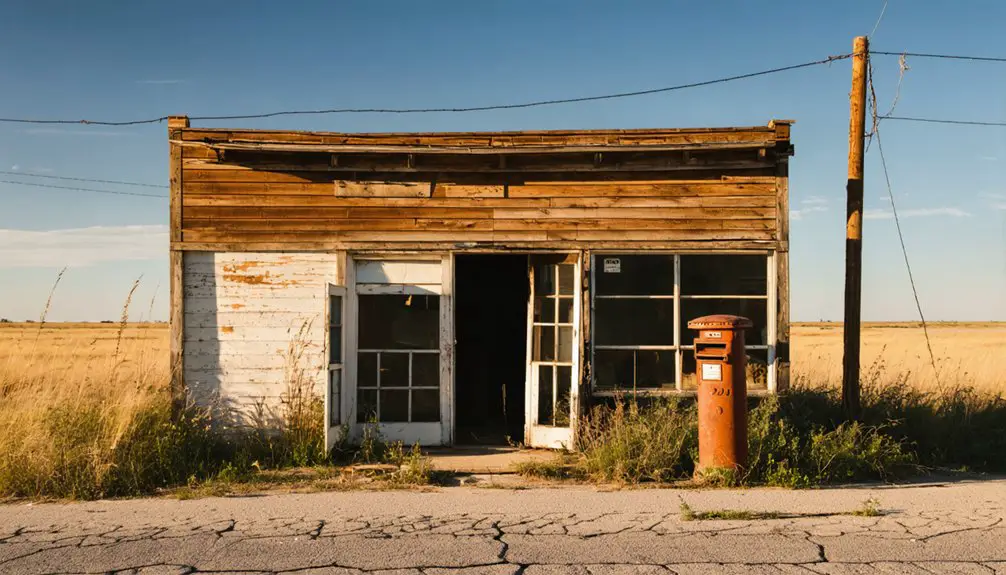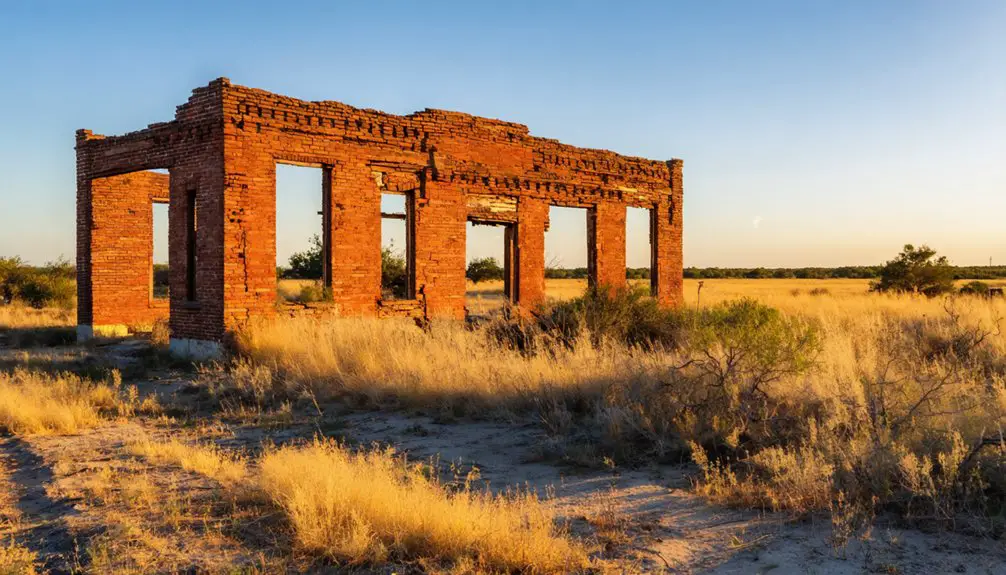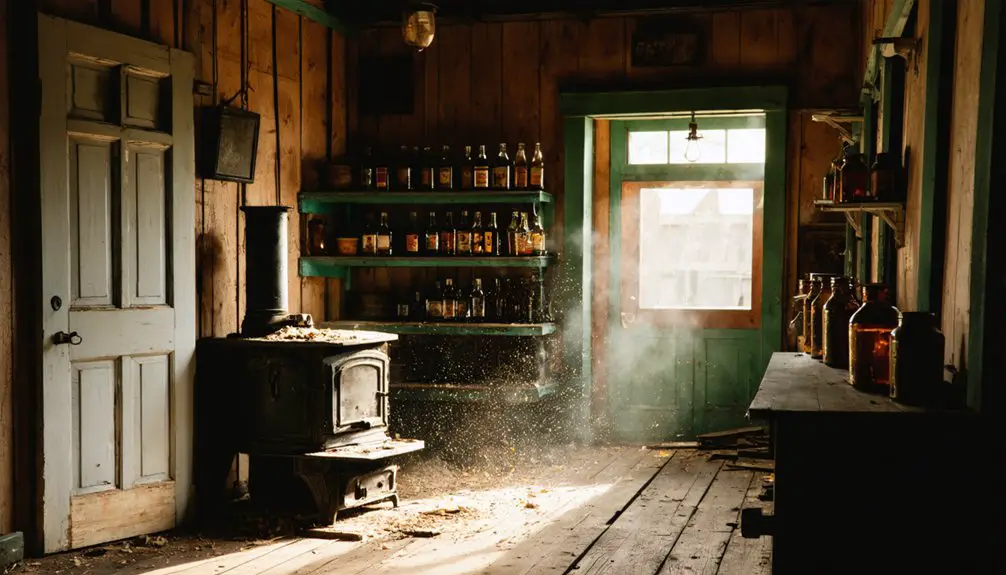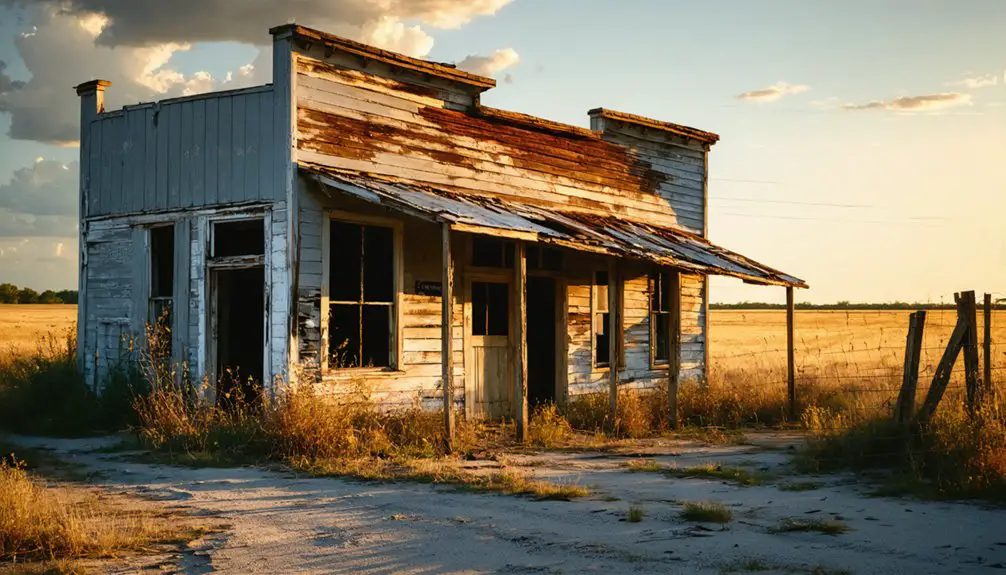You’ll find Alum’s ghost town remains at 29°17′43″N and 97°57′53″W in Wilson County, Texas. This 19th-century farming settlement grew around Alum Creek, reaching about 25 residents by 1910. The community revolved around G.A. Burris’s general store until 1920, followed by Loyd Burris’s store in 1934. Through the 1950s-1970s, urban migration led to Alum’s decline, with its last businesses closing before 2000. The town’s abandoned structures tell a deeper story of rural Texas life.
Key Takeaways
- Alum became a ghost town before 2000, following decades of decline that began in the 1950s due to urban migration.
- Located in Wilson County at 29°17′43″N and 97°57′53″W, Alum was a small farming community established near Alum Creek.
- The town’s commercial center included a general store run by G.A. Burris until 1920, followed by Loyd Burris’s store in 1934.
- The community peaked with approximately 25 residents by 1910, featuring a school established in 1936 and church active until 1990s.
- Alum’s isolation from major highways and rural location contributed to its eventual abandonment as residents moved to urban areas.
Origins and Settlement in the 19th Century
As Texas underwent westward expansion in the late 19th century, settlers established the community of Alum in Wilson County, taking its name from the nearby Alum Creek that served as a crucial water source.
The settlement patterns reflected the rugged independence of these early inhabitants, who carved out homesteads in the South Texas brushland and prairie. The community valued the local creek not only for water but also for the natural deposits of white crystals found along its banks. These deposits contained potassium alum, which was commonly used in textile dyeing and tanning processes.
Settlers displayed fierce autonomy as they established scattered homesteads across the wild South Texas frontier terrain.
You’ll find that these pioneers, drawn by the promise of available land, created a modest agricultural community before 1900. They built their lives around Alum Creek’s crucial waters, which sustained both families and livestock.
Settlement patterns remained sparse, with scattered farmsteads and ranches dotting the landscape rather than a concentrated town center. Like many frontier settlements of the era, Alum’s early inhabitants focused on building a self-sufficient existence in this untamed corner of Texas.
Rise of Early Commerce and Trade
The establishment of early commerce in Alum paralleled the town’s settlement patterns, with modest trade activities emerging before 1900. You’d have found a small but active community of about 25 residents by 1910, centered around a local store that served as the town’s primary commercial hub until 1920.
Like Glen Rio’s Kirk Patrick Hotel, the town’s first business became a cornerstone of local commerce. Similar to the decline of Belle Plain College, the town’s economy relied heavily on local agriculture, with farmers and ranchers engaging in informal trade throughout Wilson County.
While you wouldn’t have found major infrastructure like post offices or rail depots, the establishment of a school by 1936 and a church that operated into the 1990s provided gathering spaces for community exchange.
The town’s location near Alum Creek supported farming activities, though limited transportation options and distance from major highways restricted commercial growth beyond basic resident needs.
Life in Early Rural Texas
You’d find early rural Texas stores acting as crucial community hubs where farm families gathered to trade crops for essential supplies and share news of their grueling daily lives filled with sunrise-to-sunset labor.
Your typical farm household would have included large extended families of up to twenty children, though tragically about half didn’t survive past age five due to diseases like typhoid and measles.
The daily diet focused heavily on pork and corn since cattle were mainly kept for milk and labor rather than meat.
Families settling near these stores relied on traditional methods for everything – from growing their own flax and hemp for clothing to preserving meat through smoking and curing, while cooking and heating depended entirely on wood-burning fireplaces. Most families had to make do with only two or three pans for all their cooking needs.
Rural Store Communities
Rural Texas communities in the late 1800s and early 1900s revolved around general stores that served as crucial hubs of commerce and social life.
You’d find these stores stocking everything from basic food staples to farming equipment, while also housing the local post office and meeting hall. Store inventories reflected the needs of hardworking farmers and ranchers, offering independence through self-sufficiency. The shelves were filled with bins of grains and other essential dry goods that sustained the community. As seen in Fields Store, these establishments often included post offices operated by local residents.
- These stores hosted community events like picnics, dances, and rodeos.
- Local families operated stores for generations, becoming pillars of rural society.
- Stores provided essential services including cotton gins and informal medical care.
- Many incorporated meeting spaces for fraternal organizations and civic gatherings.
When you visited these rural store communities, you’d discover more than just a shopping destination – you’d find the heart of Texas frontier life, where neighbors gathered to trade news, debate issues, and strengthen community bonds.
Daily Farm Life
Before dawn broke across early Texas farms, families rose to begin their demanding daily routines that would stretch from sunup to sundown.
You’d start by feeding livestock and milking cows before heading to the fields, where you’d plow behind mules, plant crops, or battle weeds depending on the season.
Farm chores never ended – you’d repair fences, dig wells, or work in the blacksmith shop while your children helped tend animals and prepare meals.
Many ranchers relied on skilled vaqueros and cowhands to manage their cattle operations while attending to other farm duties.
Life revolved around the vital chuckwagon cook, who prepared three daily meals to keep ranch hands nourished during intensive work periods.
Seasonal activities dominated your schedule, from spring planting to fall harvest, when everyone pitched in before storms could destroy crops.
You’d preserve food through smoking, drying, and salting to sustain your family through lean times.
After 50-hour workweeks of physical labor, you’d rest briefly before starting again, your survival depending on the land’s bounty.
Family Settlement Patterns
As Stephen F. Austin’s settlers arrived in Texas during the 1820s, they established a pattern of close-knit family settlements that you’d recognize in early Alum.
Family ties became the foundation of these rural communities, with extended households sharing both living spaces and daily work responsibilities.
Here’s how kinship networks shaped settlement patterns:
- Multiple generations lived together in adjacent homesteads, maximizing labor efficiency.
- Family groups often claimed land near relatives, creating interconnected farming communities.
- Church leaders and elders governed these tight-knit settlements, maintaining social order.
- Brothers, sisters, and cousins frequently expanded settlements together into new territories.
You’ll find this emphasis on family-centered communities reflected the broader settlement trends across rural Texas, where kinship networks provided both security and economic stability in frontier conditions.
Population Changes Through the Decades

While the initial settlement of Alum, Texas occurred prior to 1900, specific population figures from its early years remain scarce in historical records.
Throughout the early 20th century, the town maintained a modest rural population without experiencing significant growth or industrial development.
You’ll find that population fluctuations took a downward turn by the 1950s, as urban migration drew residents away from Alum toward larger cities.
The decline continued steadily through the 1970s, marked by closing businesses and diminishing services.
By the 1990s, only a few inhabited houses remained, and the community had largely dispersed.
The final exodus occurred before 2000, leaving Alum completely abandoned.
Like many Texas ghost towns that peaked in the early 1900s, Alum’s population dwindled until the town faded into history.
The General Store Era
At the heart of Alum’s social and commercial life, you’d find the general store serving as the community’s primary gathering hub during the late 19th and early 20th centuries.
You could purchase essential supplies while catching up on local news and sharing stories with neighbors, making the store more than just a retail establishment.
Within the store’s wooden walls, proprietor Burris’s mercantile business provided crucial goods and services until the town’s eventual decline, marking the end of an era in Alum’s history.
Community Gathering Hub
The general store stood as Alum’s beating heart during the town’s peak years, serving both commercial and social needs of the community.
You’d find locals gathering regularly to exchange news and strengthen their bonds through casual conversations and community events. The store owner emerged as a respected leader, facilitating social interactions that shaped the town’s identity.
- Weekly town meetings and local gatherings took place at the store’s front porch
- Residents shared vital information about weather, crops, and regional developments
- The store provided an informal town hall for making community decisions
- During harvest seasons, farmers and ranchers would coordinate their activities here
Beyond basic commerce, the store created a space where you could connect with neighbors, fostering the independent spirit that defined small-town Texas life.
Burris’s Mercantile Legacy
G.A. Burris established a crucial mercantile presence in Alum, Texas, operating his general store until around 1920. You’d have found an impressive selection of dry goods there, with a remarkably upscale men’s wear section that set his establishment apart from typical rural shops.
The Burris merchandise legacy continued when Loyd Burris, after gaining experience at Blue Mercantile, opened his own store in 1934.
His community impact extended beyond commerce – you’d spot him serving in the Volunteer Fire Department, Lions’ Club, and Chamber of Commerce. As bugler and charter member of the American Legion, he exemplified how store owners became pillars of rural Texas communities.
The Burris family’s dedication to quality merchandise and civic engagement helped sustain Alum’s economic strength during the town’s prime years.
Geographic Location and Surroundings

Located in the geographic heart of Wilson County, Texas, Alum sits at coordinates 29°17′43″N and 97°57′53″W within south-central Texas.
You’ll find this ghost town nestled in a rural landscape of rolling plains and creek valleys, with Alum Creek serving as its namesake water feature. The surrounding terrain showcases the region’s natural geographic features, characterized by subtle elevation changes and agricultural lands.
- Positioned southeast of San Antonio’s metropolitan area
- Situated away from major highways and urban infrastructure
- Surrounded by a network of creeks and waterways
- Located in an area historically dominated by farming and ranching
While the town once thrived as a small settlement, its isolation from significant transportation routes contributed to its eventual abandonment before the turn of the millennium.
The Path to Abandonment
Like many rural Texas settlements, Alum’s decline began with a combination of economic and transportation challenges in the mid-20th century.
Economic shifts hit the community hard as agricultural consolidation reduced local farming opportunities, forcing families to seek work elsewhere.
You’ll find this pattern repeated across Texas, where transportation decline often sealed a town’s fate.
As essential services and schools closed, demographic trends accelerated the exodus – younger generations moved to urban areas, leaving behind an aging population that couldn’t sustain the community.
Social conflicts and lack of formal governance may have weakened Alum’s ability to adapt to these changes.
Without the economic drivers to maintain its population, the town gradually emptied until it joined the ranks of Texas ghost towns.
Physical Remnants and Landmarks

Physical evidence of Alum’s past existence remains scattered across the former townsite, where abandoned buildings stand in various states of decay.
Like many Texas ghost towns, you’ll find ghostly remnants that tell the story of a once-thriving community.
- Building foundations peek through overgrown vegetation, marking where homes and businesses once stood.
- A deteriorating church structure serves as one of the main historical landmarks.
- The old cemetery remains as a silent memorial to former residents.
- Scattered mining equipment rusts quietly in the Texas sun.
You can explore these physical remnants that paint a picture of daily life in Alum.
While many structures have succumbed to time and weather, the remaining features provide tangible connections to the town’s past, allowing you to step back through history.
Legacy in Texas History
Beyond the weathered structures and silent foundations, Alum’s enduring significance lies in its representation of early Texas rural life.
You’ll find its cultural significance woven into the fabric of Wilson County’s history, where it stands as a symbol to pre-1900s settlement patterns along natural waterways.
Unlike Texas’s famous boomtowns driven by oil or mining, Alum’s historical narratives reflect a more common story – that of small agricultural communities that once dotted the landscape.
While oil wells and mines created Texas legends, countless farming towns like Alum shaped the true story of rural life.
You can trace its arc from settlement to abandonment in Texas archives, where it’s preserved as an educational cornerstone for understanding rural depopulation.
Today, Alum’s transformation into a ghost town before 2000 serves as a powerful reminder of the economic shifts that continue to reshape Texas’s rural communities.
Frequently Asked Questions
What Natural Resources or Minerals Were Found in the Alum Area?
You’ll find alum deposits along Alum Creek, suggesting natural aluminum salts in the water and soil, though there’s no evidence of significant alum mining or other mineral deposits here.
Were There Any Notable Crimes or Conflicts in Alum’s History?
You won’t find documented crime incidents or specific conflict history for this location, though nearby boomtowns experienced typical frontier-era violence and lawlessness during Texas’ development in the early 1900s.
What Was the Average Land Price in Alum During Its Peak?
Like a puzzle missing its key piece, you won’t find exact land values for Alum’s peak. Based on nearby ghost towns’ economic factors, you’re looking at roughly $5-20 per acre.
Did Any Famous Personalities or Historical Figures Visit Alum?
You won’t find any documented famous visitors in Alum’s history. The town’s limited historical significance, small population, and rural location didn’t attract well-known personalities throughout its existence.
What Traditional Festivals or Community Gatherings Were Celebrated in Alum?
You’d likely find church gatherings and small farming celebrations in Alum, though specific festivals aren’t documented. Like other rural Texas communities, they probably shared meals and marked harvests together.
References
- https://kids.kiddle.co/Alum
- https://www.youtube.com/watch?v=fP2EVY0_O2k
- https://texashighways.com/culture/history/the-lost-underwater-towns-of-texas/
- https://www.chron.com/life/travel/article/Texas-ghost-towns-sure-to-5820152.php
- https://en.wikipedia.org/wiki/List_of_ghost_towns_in_Texas
- https://www.tshaonline.org/handbook/entries/alum-tx
- https://mix931fm.com/texas-ghost-towns-history/
- https://www.tshaonline.org/handbook/entries/alum-creek-tx
- https://en.wikipedia.org/wiki/Alum
- https://texashighways.com/travel-news/four-texas-ghost-towns/



